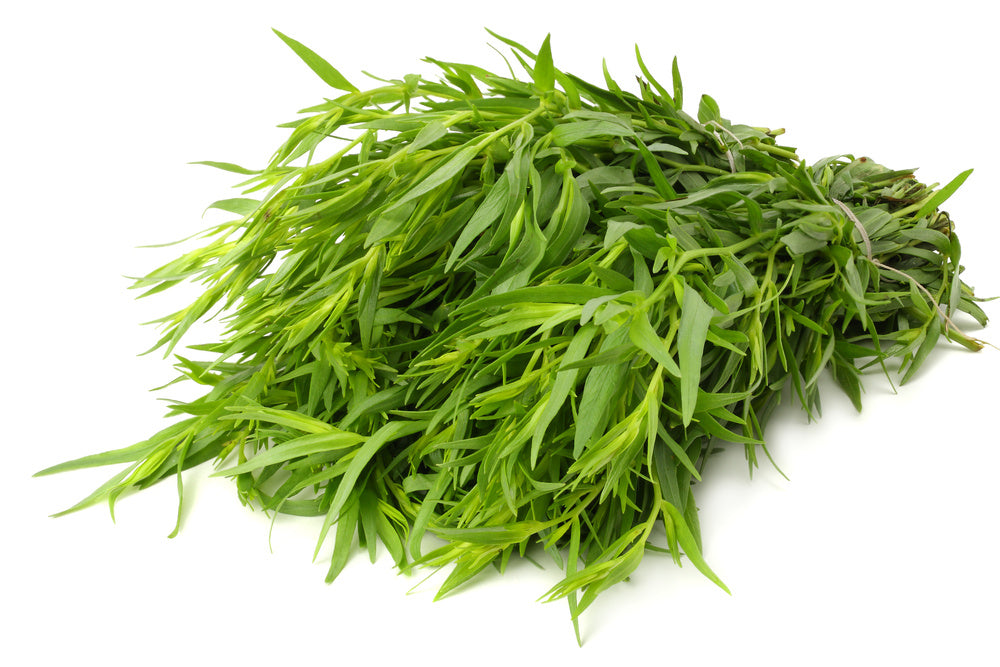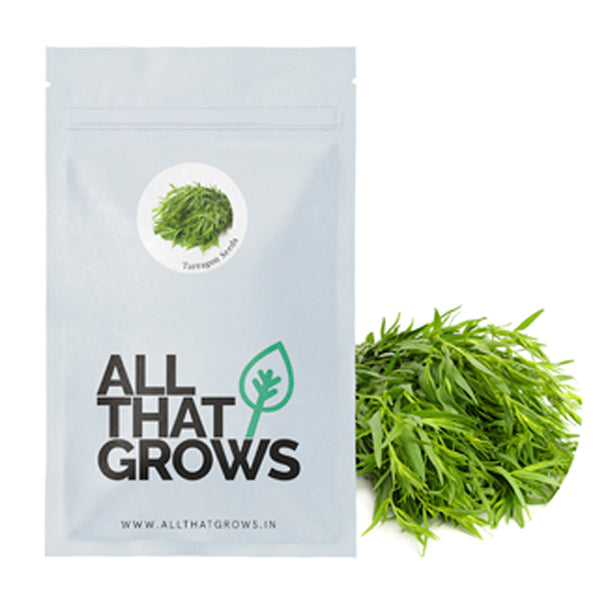



- SOWING
TIMEFebruary to May
- Sowing
DistancePlant to Plant - 18 to 24 inches
- Fruit
WeightN/A
- Fruit
ShapeN/A
- Days to
maturity75 to 85 days after germination
- Details
- How to sow
- Reviews
A member of the sunflower family, Tarragon is a tender and leafy herb that is believed to have originated from Siberia and Mongolia. The name tarragon comes from the Latin word dracunculus or little dragon owing to the appearance of its roots. Tarragon is also widely cultivated in France and is regarded as one of the “fines herbes”. The young branches grow on the sides of the central stem of Tarragon and the plant can grow upto 40 to 50 inches in height. The flavours bear a resemblance to star anise and have very subtle sweet notes. Tarragon is known to have been used as a medicinal herb for it’s anti-inflammatory properties. It also contains beta-carotene, and antioxidants that are beneficial for overall health. Tarragon has strong flavours and can be overwhelmingly powerful in a recipe. Hence it is best used judiciously.Tarragon pairs well with vegetables like potatoes, beans, carrots, asparagus etc.
Planting instructions
Tarragon will thrive in temperate climates when planted in full sun. Sow seeds at a depth of ½ inch in a sunny location in well-drained soil. Tarragon can also be planted in sandy soils mixed with coco peat. Seeds will start to germinate in 10 to 14 days after sowing. If your area has harsh weather, it’s best to start the seeds indoors in a sunny location, and then transplant them outdoors once they are about 3 inches long.
Growing Requirements
pests
Tarragon is prone to pests like spider mites, whitefly and aphids. Organic canola oil or diluted neem spray can be used to deter these pests from the Tarragon plant. Moreover, the plant is also susceptible to diseases like powdery mildew and root rot in case the soil drainage is poor.
soil
Well draining loamy soil is best to grow Tarragon. Be wary of compact soil that is too acidic. Ideal soil pH should range between 6.3 to 7.5
spot
Choose a location that receives full sun for 4 to 5 hours in the day. Tarragon can also tolerate partial shade.
temperature
Temperate climate is best to grow Tarragon, extreme weather conditions can result in unhealthy plants. Ideal soil temperature for germination of tarragon should range between 18 to 25℃.
watering
Keep the soil evenly moist till the time tarragon plants have well established roots. After that reduce the watering to alternate days.
how to harvest
Tarragon leaves must be harvested once the plant is 10 inches long. Snip the leaves from the branches for use. Keep pruning the top of the plant occasionally to retain the flavours and promote more foliage growth. Tarragon leaves are best used fresh or can be stored in damp paper towels kept in the refrigerator. Dried tarragon must be stored in an airtight container.

Customer Reviews
The productiveness of any seed we sell is subject to your local climatic conditions*, the sowing method you adopt, and your commitment to the planting process. We give no warranty, expressed or implied, and are in no way responsible for the produce.
Please note that all our seasonal recommendations/ sowing information is as per the local climatic conditions. *For more information on the optimum conditions required for growing seeds in your region, please contact us at, hello@allthatgrows.in or Whatsapp us at, +91 8544865077
Questions & Answers
Have a Question?
Be the first to ask a question about this.




Tarragon Seeds
Seed Type : Non-Hybrid, Open Pollinated and Non-GMO
SOWING TIME : February to May
PLANT CHARACTER : Tender plant grows upto 50 inches
LEAF CHARACTER : Glossy lanceolate leaf
HARVEST : 75 to 85 days after germination
Grow this with
A member of the sunflower family, Tarragon is a tender and leafy herb that is believed to have originated from Siberia and Mongolia. The name tarragon comes from the Latin word dracunculus or little dragon owing to the appearance of its roots. Tarragon is also widely cultivated in France and is regarded as one of the “fines herbes”. The young branches grow on the sides of the central stem of Tarragon and the plant can grow upto 40 to 50 inches in height. The flavours bear a resemblance to star anise and have very subtle sweet notes. Tarragon is known to have been used as a medicinal herb for it’s anti-inflammatory properties. It also contains beta-carotene, and antioxidants that are beneficial for overall health. Tarragon has strong flavours and can be overwhelmingly powerful in a recipe. Hence it is best used judiciously.Tarragon pairs well with vegetables like potatoes, beans, carrots, asparagus etc.
Seed Type : Non-Hybrid, Open Pollinated and Non-GMO
SOWING TIME : February to May
PLANT CHARACTER : Tender plant grows upto 50 inches
LEAF CHARACTER : Glossy lanceolate leaf
HARVEST : 75 to 85 days after germination
- SOWING
TIMEFebruary to May
- Sowing
DistancePlant to Plant - 18 to 24 inches
- Fruit
WeightN/A
- Fruit
ShapeN/A
- Days to
maturity75 to 85 days after germination
Planting instructions
Tarragon will thrive in temperate climates when planted in full sun. Sow seeds at a depth of ½ inch in a sunny location in well-drained soil. Tarragon can also be planted in sandy soils mixed with coco peat. Seeds will start to germinate in 10 to 14 days after sowing. If your area has harsh weather, it’s best to start the seeds indoors in a sunny location, and then transplant them outdoors once they are about 3 inches long.
Growing Requirements
pests
Tarragon is prone to pests like spider mites, whitefly and aphids. Organic canola oil or diluted neem spray can be used to deter these pests from the Tarragon plant. Moreover, the plant is also susceptible to diseases like powdery mildew and root rot in case the soil drainage is poor.
soil
Well draining loamy soil is best to grow Tarragon. Be wary of compact soil that is too acidic. Ideal soil pH should range between 6.3 to 7.5
spot
Choose a location that receives full sun for 4 to 5 hours in the day. Tarragon can also tolerate partial shade.
temperature
Temperate climate is best to grow Tarragon, extreme weather conditions can result in unhealthy plants. Ideal soil temperature for germination of tarragon should range between 18 to 25℃.
watering
Keep the soil evenly moist till the time tarragon plants have well established roots. After that reduce the watering to alternate days.
how to harvest
Tarragon leaves must be harvested once the plant is 10 inches long. Snip the leaves from the branches for use. Keep pruning the top of the plant occasionally to retain the flavours and promote more foliage growth. Tarragon leaves are best used fresh or can be stored in damp paper towels kept in the refrigerator. Dried tarragon must be stored in an airtight container.



 Sign In
Sign In








